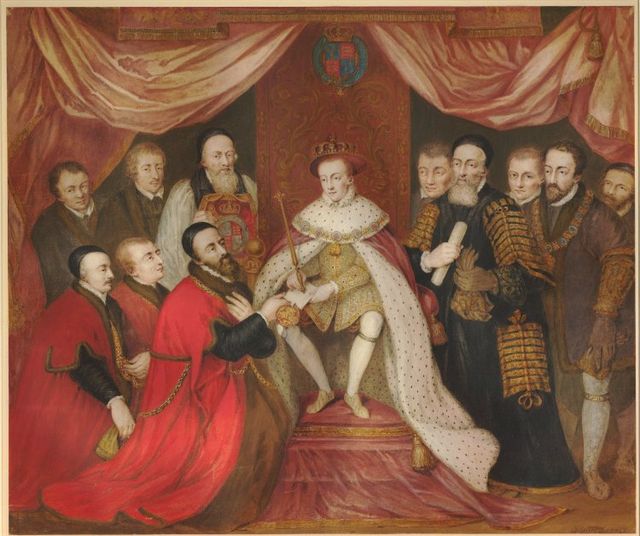
Just under a month after the death of Henry VIII, his nine-year old son Edward VI was crowned King of England. Because of Edward’s youth, the formalities were streamlined so they would take seven hours instead of the traditional twelve. We have a wonderful description of the event, thanks to John Gough Nichols who assembled The Literary Remains of Edward VI in 1857. First, to set the stage:
At the cathedral church of Westminster, […] the quire was very richly hung with cloth of Arras and well strewn with rushes, and the place between the high altar and the chair also.
Then there was made and ordained a mounting scaffold, with stairs up to the same, and down to the altar, on which there was a throne of seven stairs, whereof four of the uppermost were covered with fine brocade, and the other stairs covered with carpets; and upon the middle of the throne there was set a great white chair covered with brocade, damask, and gold, with two cushions; whereof one was black velvet embroidered with gold very richly, and the other of cloths of tissue. The said chair had two pillars, at the backs whereof there stood two lions of hold, and in the middle a turret with a flower of lace of gold. The said place was guarded with four gentlemen ushers, daily waiters, viz. Mr. William Raynsforde, Mr. John Norris, Mr. Richard Greenway, Mr. Richard Blount, besides divers other gentlemen ushers to assist them.”
https://archive.org/details/literaryremains00clubgoog/page/n325/mode/2up?view=theater
Nichols goes on to describe the ceremony itself, beginning with how Edward first sat in King Edward’s Chair,
“…wherein after his grace had reposed a little time, he was removed by his said lords into another chair, garnished with rich cloth of tissue, wherein he sitting the four gentlemen ushers carried his grace in to the four parts of the mount that he might be seen of the people; besides whom the archbishop of Canterbury, standing did declare unto the people in all the aforesaid parts the King’s Majesty’s free election, with these words following: ‘Sire, here present is Edward rightful and undoubted inheritor by the laws of God and man to the crown and royal dignity of this realm, whereupon you shall understand that this day is prefixed and appointed by all the peers of this realm for the consecration, enunction, and coronation of the said most excellent Prince Edward. Will ye serve at this time, and give your wills and assents to the same consecration, enunction, and coronation?’ Whereunto the people answered all in one voice, Ye, ye, ye, God save King Edward. Then his grace was brought unto the said throne again. And immediately was conveyed in the said chair by the gentlemen ushers before the high altar, upon the which he offered up his pall of brocade and twenty shillings; verifying the words of scripture, where as it is written, ‘Thou shalt not appear void before the Lord God.’ Then a little after he returned to his chair, the cushion of velvet was lad before the altar, upon which his grace laid prostrate whilst certain oraisons were said over him.”
https://archive.org/details/literaryremains00clubgoog/page/n325/mode/2up?view=theater
There was a lot more after this before they repaired to Westminster’s Great Hall for a feast: the enunction/anointing of Edward and his regalia, the coronation with three crowns (King Edward’s crown, the imperial crown of England, and a third very rich crown specially made for the boy), the gold ring set upon his finger, the homage of his nobles and government…and of course prayers all around and in between. But that all must have passed in a bit of a blur for Edward himself – and I say that because his description in his Chronicle skips it entirely.
Such an amazing document, that Chronicle. Written in the third person by a boy who was far too conscious of the far-ranging nature of his every word and gesture, Edward focused on the things that were “important”. Even his wonder at being allowed to wear the crown at dinner after the coronation itself speaks to that gravitas…it is heart wrenching in its own way. In the new king’s own words:
Afterwards, all things being prepared for the coronation the King being then but nine years old, passed through the City of London as heretofore hath been used, and came to the Palace of Westminster, and the next day came into Westminster Hall, and it was asked the people whether they would have him to be their King. They answered, “Yea, yea.” Then he was crowned King of England, France and Ireland by the Archbishop of Canterbury and all the rest of the clergy and nobles and anointed with all such ceremonies as were accustomed, and took his oath, and gave a general pardon, and so was brought to the hall to dinner, Shroft Sunday, where he sat with the crown on his head, with the Archbishop of Canterbury and the Lord Protector, and all the lords sat at boards in the hall beneath; and the Lord Marshall’s deputy, for my lord of Somerset was Lord Marshall, rode about the hall to make room.
https://archive.org/details/cu31924091758312/page/n19/mode/2up
It was a glorious day – and I’m just going to let it sit there instead of looking ahead only five short years later…
***
If you like my posts, you’ll love my books! My Seymour Saga trilogy tells the gripping story of the short-lived dynasty that shaped the Tudor Era. Jane the Quene skews romantic, The Path to Somerset is pure Game of Thrones (without the dragons), and The Boy King is a noir coming-of-age. Get them now through Amazon, Barnes & Noble, Kobo, and Apple, or even your local independent bookstore!

(PS Already read them? Did you love them? Then please review them – even just a stars rating! It makes a huge difference in helping new readers find them and would mean the world to me!)

Be First to Comment